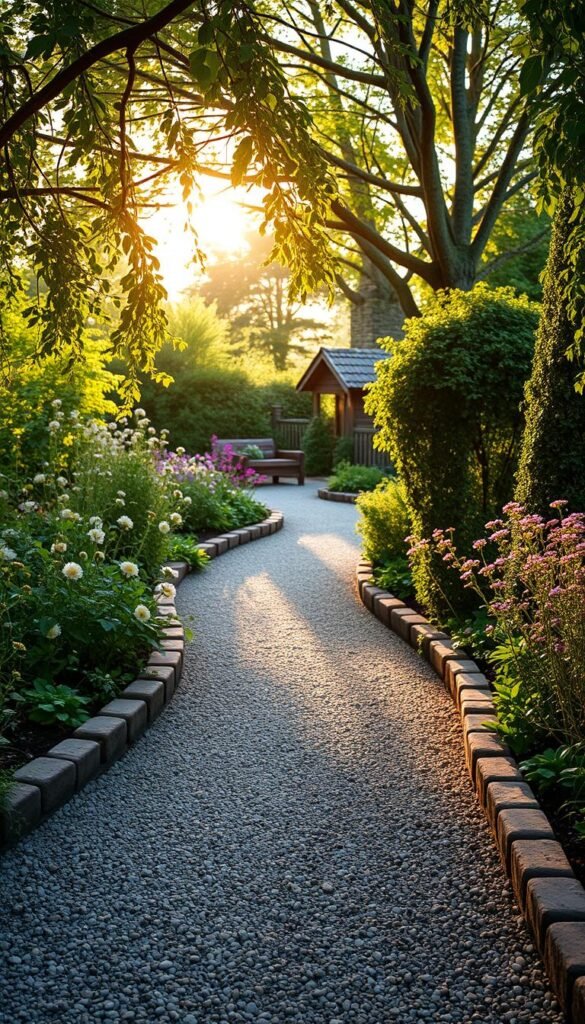Picture a winding walkway framed by blooming perennials, where every step feels like a journey through nature’s artwork. This is the magic of countryside-inspired spaces—where pathways become more than routes. They’re invitations to slow down and savor the timeless charm of your outdoor sanctuary.
These organic walkways blend function with fairytale allure, guiding visitors through floral tapestries while creating visual harmony. The right materials—like crushed limestone or weathered flagstones—add texture and character. Over time, moss-filled gaps between stones or softened brick edges deepen that lived-in authenticity cherished in rustic designs.
When planning your walkway, consider how curves can transform small areas into explorative havens. Studies show winding routes double exploration time compared to straight lines, making spaces feel larger. Pair this with cottagecore aesthetic touches like silvered cedar edging for cohesive whimsy.
Your choice of surface sets the tone. Gravel offers casual crunch underfoot, while irregular slate pieces create artful asymmetry. Each option balances practicality with poetic appeal, ensuring your path remains durable yet dreamy through seasons.
The Allure of Cottage Garden Paths
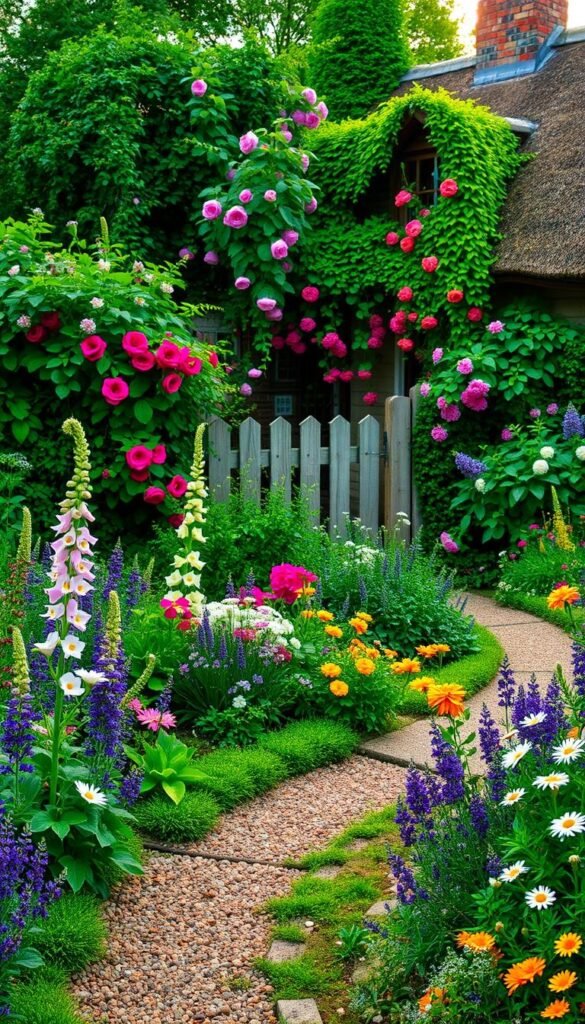
There’s a special kind of magic in spaces that feel both wild and welcoming. Unlike formal landscapes with clipped hedges and perfect symmetry, these designs celebrate life’s beautiful imperfections. Think roses tumbling over fences and herbs brushing against your ankles as you wander—a living mosaic that evolves with every season.
What Makes Cottage Gardens Unique
These spaces thrive on diversity and density. Instead of orderly rows, you’ll find lavender spilling onto walkways and foxgloves nodding above thyme. This layered approach creates habitats for pollinators while wrapping you in a fragrant embrace. As one gardener puts it: “It’s like walking through a storybook where every plant has a role.”
Setting the Stage for Your Garden Retreat
Privacy plays a key role in their charm. Tall hollyhocks and arched trellises draped in clematis form natural screens, turning corners into secret alcoves. You might stumble upon a bench nestled among flowering shrubs—a quiet spot to savor mint tea or birdsong.
Edibles mingle freely here too. Strawberries peek through geraniums, while rosemary edges blend practicality with perfume. This mix isn’t just pretty—it’s a smart way to maximize limited space. Over time, your path becomes framed by nature’s own artistry, with creeping thyme softening stone edges or violets dotting gravel.
The Whimsical Appeal of Cottage Gardens
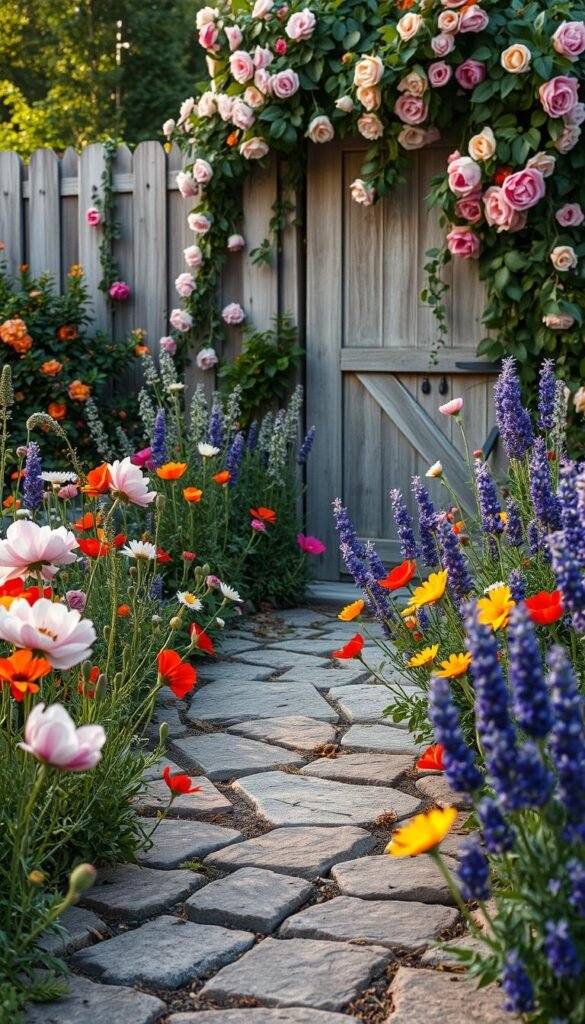
Stepping into these spaces feels like wandering into a vibrant tapestry woven by nature’s hand. English roses mingle with spiky delphiniums and feathery lavender, creating a living mosaic that buzzes with bees and fluttering butterflies. “It’s not just planting—it’s composing a symphony,” shares a seasoned grower from Vermont. This artful chaos invites exploration, where every glance reveals new details.
What seems random is carefully orchestrated. Tall foxgloves frame shorter clusters of thyme, while purple salvias pop against creamy shasta daisies. You’ll notice blooms arranged in drifts rather than rows, ensuring color waves from spring’s pastel peonies to autumn’s golden rudbeckias. The magic? Plants like columbines and poppies self-seed freely, creating joyful surprises each year.
These spaces thrive on contrasts—velvety petals brushing against spiky foliage, soft herbs carpeting stone edges. This layered approach does more than please the eye. It shelters ladybugs, feeds hummingbirds, and offers nesting spots for wrens. Studies show biodiverse plantings support 35% more pollinators than manicured beds.
Beyond ecology, there’s nostalgia. The scent of old-fashioned roses or rustling hollyhocks might transport you to grandma’s backyard. Yet modern twists keep it fresh—try pairing heirloom varieties with drought-tolerant yarrow for low-maintenance charm. The result? A space that feels both timeless and uniquely yours.
The Many Benefits of a Charming Garden Path
Imagine strolling through your outdoor space where every turn reveals new delights. A thoughtfully designed walkway does more than connect points—it transforms how you experience your landscape. Let’s explore how these functional features elevate both practicality and beauty.
Enhanced Accessibility & Safety
Well-crafted paths create stable routes for everyone. Grandparents can navigate safely, while kids avoid trampling delicate blooms. Materials like packed gravel or flat stones provide traction, even after rain. No more muddy shoes or uneven steps!
Clear walkways also protect your plants. By directing foot traffic, you’ll spend less time replanting crushed perennials. Research shows proper paths reduce soil compaction by 40%, keeping roots healthier.
Boosting Visual Interest and Organization
Paths act as nature’s blueprint. They separate veggie patches from seating areas while maintaining flow. Try lining edges with spring bulbs or autumn mums—seasonal colors that guide the eye.
Curved designs invite exploration. A bend might reveal a hidden bench or birdbath, creating moments of surprise. As one landscaper notes: “Great paths make the journey as rewarding as the destination.”
| Benefit | Impact | Best For |
|---|---|---|
| Accessibility | Supports all mobility levels | Sloped gardens |
| Safety | Reduces slips/falls | Wet climates |
| Low Maintenance | Cuts replanting by 60% | Busy homeowners |
Your path’s design can even solve problems. Narrow routes between raised beds maximize growing space. Wider curves accommodate wheelbarrows. Every choice enhances function while reflecting your style.
Choosing the Right Materials for Your Garden Path
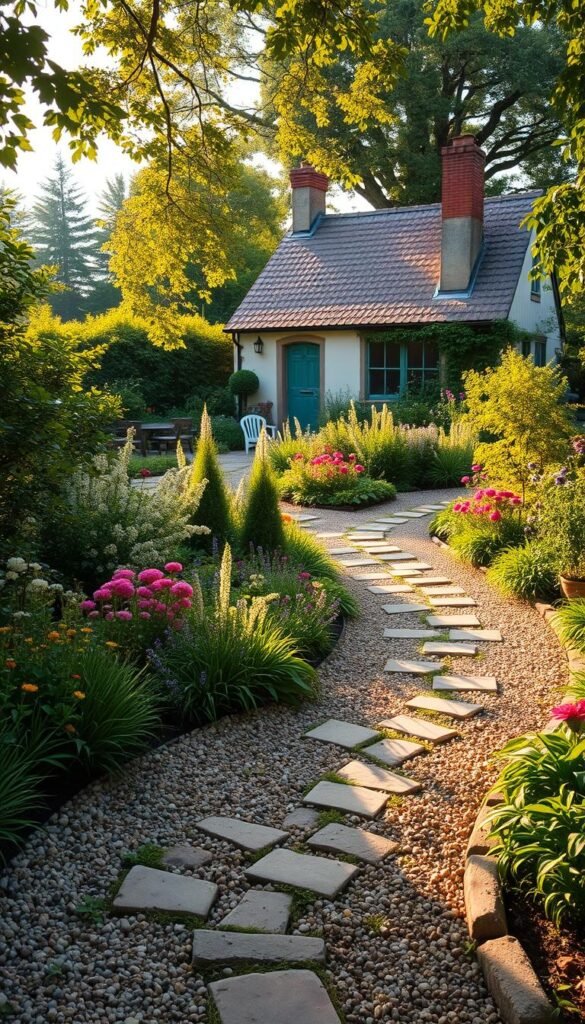
Your walkway’s foundation sets the stage for its story. Materials determine whether footsteps crunch playfully or glide silently, whether moss creeps between cracks or patterns demand attention. Let’s uncover which options blend durability with that effortless charm you crave.
Gravel, Brick, Stone and More
Crushed stone brings casual elegance to curved designs. It’s budget-friendly and drains well—perfect for rainy regions. “Gravel’s whisper underfoot adds music to your morning stroll,” notes a Maine landscaper. For stability, pair it with rusted steel edging.
Brick delivers old-world character through patterns like herringbone or basketweave. Its warm red tones pop against lavender borders, though frost-prone areas need thicker pavers. Reclaimed bricks? They’ll give instant patina.
- Flagstone: Natural slabs create artful asymmetry
- Wood rounds: Ideal for woodland-themed spaces
- Concrete pavers: Modern twist on classic looks
Slate and limestone offer timeless appeal with minimal upkeep. Their earthy hues harmonize with flowering groundcovers—think creeping thyme or Irish moss filling the gaps. Wood suits damp climates less but shines in dry, shaded spots.
| Material | Lifespan | Maintenance |
|---|---|---|
| Brick | 25+ years | Weed control |
| Gravel | 10-15 years | Annual topping |
| Flagstone | Lifetime | Occasional leveling |
Mix materials for visual intrigue—try stone steppers flanked by pea gravel. Your choice should mirror both your climate and the carefree spirit of your outdoor sanctuary.
Designing a Functional & Inviting Path Layout
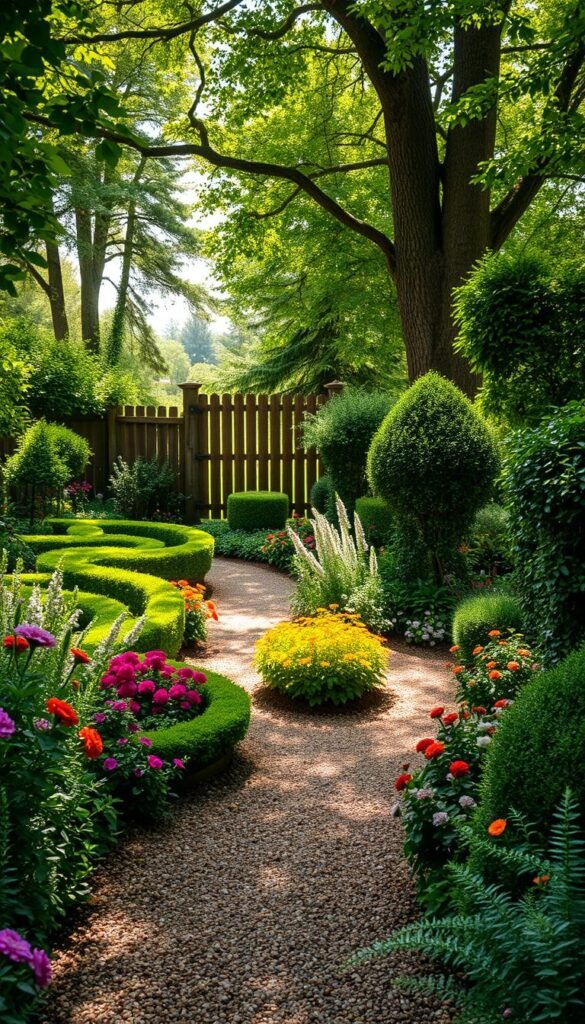
Crafting the perfect walkway begins with understanding your landscape’s natural rhythm. Observe how sunlight dances across open areas or where rainwater collects after storms. These details shape a practical yet enchanting route that feels organic to your outdoor space.
Mapping Out Your Garden Space
Start by sketching key destinations: entry points, seating nooks, or flower beds. A Vermont landscaper suggests: “Great design works with the land, not against it.” Use a garden hose to test curves—gentle bends feel more inviting than sharp corners. This trial run helps visualize flow before any digging begins.
Main routes should comfortably fit two people (48-60 inches wide), while secondary trails can narrow to 24 inches for cozy charm. Steeper slopes? Add gradual inclines and textured surfaces for safety. Wider sections near benches create natural pause points to admire your blooms.
| Pathway Type | Ideal Width | Key Features |
|---|---|---|
| Primary | 48-60 inches | Accommodates wheelbarrows, pairs walking |
| Secondary | 24-36 inches | Intimate, connects hidden areas |
Balance beauty with purpose by aligning materials to your terrain. Crushed stone suits flat zones, while irregular flagstones anchor sloped sections. Remember: curves slow movement, encouraging visitors to savor every twist and turn. Your layout should whisper, “Explore me,” while guiding feet effortlessly through the scenery.
Cottage Garden Path Ideas: Gravel, Brick, or Stone for a Quaint Ambiance
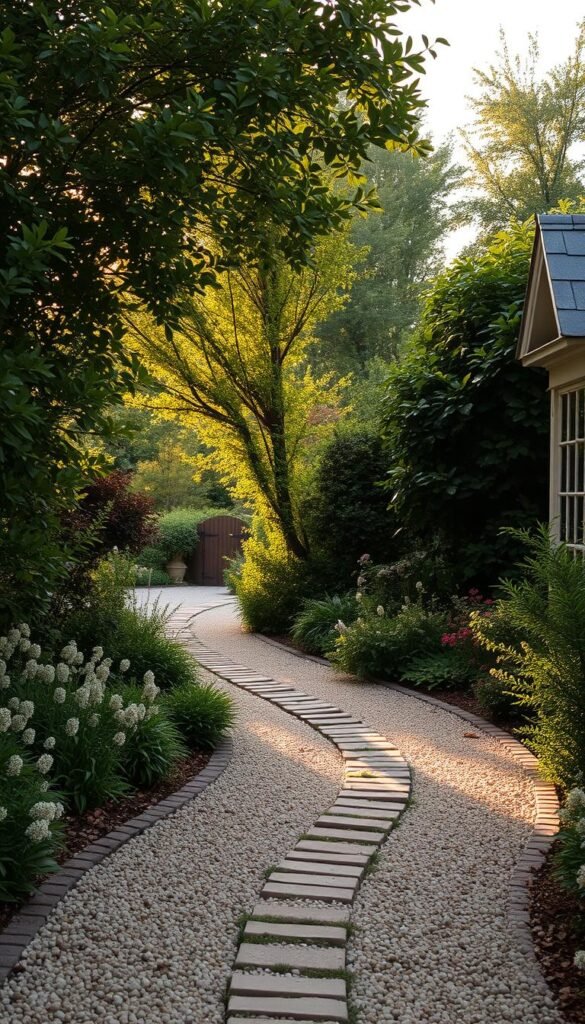
Discover how the right materials can turn a simple walkway into a storybook journey. Start with gravel paths that crunch underfoot like autumn leaves. Choose pea-sized stones in warm buff or gray tones, edged with weathered steel to prevent spread. Let creeping phlox spill over borders for softness—nature’s way of blurring hard lines.
Brick layouts bring heritage charm. Reclaimed pavers laid in casual patterns age gracefully, their cracks inviting moss or thyme. A Maine designer suggests: “Offset every third brick to create rhythm—like a melody under your feet.” Pair with lavender borders for scent that lingers in summer air.
Natural stone pathways feel unearthed rather than built. Irregular flagstones nestle into soil, edges softened by sedum or ajuga. For stability, set slabs on sand beds, leaving inch-wide gaps for self-seeding violas. These organic layouts weather beautifully, developing patinas that mirror aged garden walls.
Mix materials for playful contrast. Try gravel centers with brick edging, or stone steppers surrounded by crushed shells. Blend textures by planting woolly thyme between slate pieces—it releases fragrance when brushed. Local touches matter: use regional rocks or handmade ceramics as stepping stones.
Consider climate when choosing surfaces. Gravel drains well in rainy areas but may scatter in wind. Brick stays cool in heat yet needs sealing in frost zones. Stone withstands decades but requires occasional leveling. Your path should grow more charming with time, becoming a testament to thoughtful design.
Inspirational Stepping Stone and Paver Designs
Transform your outdoor space into a gallery where every step showcases personality. Artistic pathways blend craftsmanship with nature, turning functional routes into visual narratives. Whether you prefer earthy textures or geometric precision, your walkway becomes a canvas for self-expression.
Rustic Stepping Stone Options
Natural flagstone pieces with irregular edges create meandering charm. Set them in grass for a timeworn look, allowing clover or moss to fill gaps. For stability, lay slabs on sand beds and surround with pea gravel—its soft crunch contrasts beautifully with stone’s solidity.
Creative Brick and Paver Patterns
Reimagine classic materials with layouts like herringbone or circular sunbursts. Mix brick hues for depth, or alternate pavers with planted pockets of creeping thyme. A landscaper suggests: “Let patterns guide the eye—curved designs feel playful, straight lines add calm.”
Explore stepping stone paths that balance artistry and function. Mosaic accents add whimsy, while oversized slabs create bold statements. Your pathway isn’t just a route—it’s the signature piece that ties your outdoor story together.

